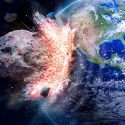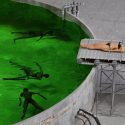Over 300 million years ago, before the age of giant dinosaurs, Earth was covered with giant insects. Imagine a world where dragonflies are the size of crows and millipedes are as long as cars. Welcome to the Carboniferous Period. Why were insects so enormous during this time? What did oxygen have to do with it? And why did these insects go extinct?
The Carboniferous Period was one of the most transformational periods in the history of Earth. The planet’s landmasses were beginning to form the supercontinent of Pangea. Extensive swamps and warm, humid forests dominated the landscape. And giant insects weren’t the only huge creatures roaming the planet. There was also a vast array of marine life, like early forms of sharks and a giant amphibian that would reach up to 6 feet long.
Now, the first thing you’ll probably notice would be the giant insect like creatures. One of the most iconic was the meganeura. This insect resembled a modern-day dragonfly, except with a major twist. It had a wingspan of up to 75 centimeters (30 in.). Scarier than that, it was carnivorous, hunting down other insects and small amphibians. Hopefully, it doesn’t come for you.
So, that thing is in the sky, but on land, you’ll have the arthropleura. This millipede-like creature could grow up to 2.5 m (8 ft) long. Luckily, it wouldn’t go after you. It preferred munching on decomposing vegetation. Another creepy-looking insect was the pulmonoscorpius. This was a giant scorpion that mostly roamed the swampier areas of Earth. They could grow 70 cm (28 in) long. There were also giant cockroaches that grew to 10 cm (4 in) and mayflies with 45 cm (18 in) wingspans.
So it’s safe to say that you’d have a lot to watch out for when you’re wandering around in this period. But the question is, how did these insects get so big anyway? Well, you may have noticed as you’ve been hanging out in the Carboniferous age you feel a lot more energetic and alert. Maybe you’ve had an easier time running around? This has to do with the oxygen levels in your current world.
Research has estimated that atmospheric oxygen levels were as high as 35% during this period. Compared that to the 21% we breathe today. Oxygen was one of the key factors of the gigantism found in insects at the time. But why would this make them so giant?
Insects breathe differently from other creatures. Insects don’t have a circulatory system to transport oxygen, instead, it gets delivered directly to their tissues through a network of tiny tubes called the tracheae. The more oxygen in the atmosphere, the bigger these insects are. But there might be more reasons why the insects grew to this size. Another theory suggests that the insects were forced to grow so large due to oxygen toxicity.
As amazing as oxygen is, you can have too much of a good thing. Too much oxygen in your body can create what’s known as “free radicals.” These are unstable molecules that can damage your cells and even damage your DNA. In the case of our insects, they were forced to grow this big. Otherwise, they’d suffer oxygen toxicity.
Growing larger would slow down the rate of oxygen absorbtion, making it harder to suffer from too much oxygen. And the same could happen to you. The longer you’re in this period, the higher oxygen levels cause you to experience nausea, respiratory issues, and even some effects on your nervous system.
Now, insects were arguably the stars of this age, but they weren’t the only things to experience massive change during the Carboniferous Period. This time was also known as the “coal age.” That’s because of the extensive coal beds that formed after ancient forests decayed. These coal beds are one of our main sources of energy. We’re still using them today.
And, a lot of the fruits and veggies you find in the grocery store may be descendants of plants from over 300 million years ago. The Carboniferous Period saw the evolution of the first seed-bearing plants, creating more diverse ecosystems than we’d ever seen before.
Wait – what’s that over there? Kind of looks like a dinosaur. Hey, little guy. It turns out this wasn’t a dino, just one of the first reptiles to ever appear. But if you stick around a couple of million more years we’ll enter the Mesozoic Era, which was known as ‘the age of dinosaurs.
Speaking of change, the atmosphere was another part of Earth that evolved during this period. Earth had a lush, greenhouse-like climate when you first arrived. Warm and humid temperatures to support the swampy forests we’ve been mucking about.
But as the period progressed, over millions of years, the climate transitioned to what’s known as an Icehouse Earth state. The temperature would get significantly lower, and ice sheets would begin to form, mainly in the southern hemisphere. But why did this happen?
As we’ve been exploring this crazy period, Earth’s landmasses have been slowly forming together to create a supercontinent known as Pangea. And when landmasses this big start to move, it can seriously affect ocean currents, wind patterns, and global climate.
Now, the rainforests have collapsed, which has led to a decline in the fauna and vegetation that were previously booming. With the rainforests in decline, that means oxygen levels are being reduced. Before you know it, our massive insects start dying and going extinct. Without the higher levels of oxygen available to support their size, these giant insects can’t survive.
The oxygen levels and the drier climate have created a habitat better suited for smaller insects. Also happening at this point, early reptiles are starting to take over, making the landscape way more difficult for the insects. OK now, with Pangea fully formed, we’ve entered the Permian Period. What happens at this point in history?



























